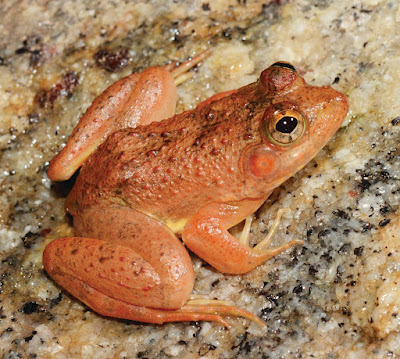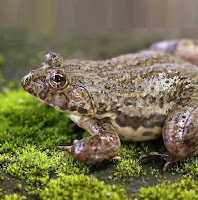 |
| Euphlyctis jaladhara Dinesh, Channakeshavamurthy, Deepak, Shabnam, Ghosh & Deuti, 2022 |
Abstract
The aquatic frog genus ‘Euphlyctis’ is now considered under two separate genera- Euphlyctis Fitzinger and Phrynoderma Fitzinger, with four valid species in each genus, respectively. The current distribution range of the genus Phrynoderma is restricted to peninsular India and Bangladesh, with a probability of availability in Sri Lanka. The genus Euphlyctis has a wide range of distribution from the Arabian Peninsula and the South Asian countries, with a few historical descriptions treated as junior synonyms of the species Euphlyctis cyanophlyctis in India. A new species of skittering frog, Euphlyctis jaladhara sp. nov. is described here from the surroundings of the Thattekad Bird Sanctuary of Kerala, India, which has a predominant distribution in the western coastal plains of peninsular India and some parts of the Western Ghats. The new species has distinct morphological characters and a high genetic distance that distinguishes it from the sympatric species. Discussions are made concerning the validity of the species E. ghoshi and E. kalasgramensis.
Keywords: Amphibia, Coastal plains, Euphlyctis, India, skittering frog, Western Ghats
 |
| Euphlyctis jaladhara sp. nov. from the surroundings of the Thattekad, Bird Sanctuary. |
 |
| Female of Euphlyctis jaladhara sp. nov. in life. |
Euphlyctis jaladhara sp. nov.
Etymology: The new species epithet is derived from the Sanskrit word Jaladhârâ (jala = water + adhâra = reservoir), meaning ‘deposit of water’. The new species is treated as a symbol of freshwater resources, as this frog is seen floating on the surface of freshwater ponds / streams during both day and night time. The species epithet is treated as a noun in apposition to the generic name.
Suggested common name: ‘Jaladhara Skittering Frog’.
K.P. Dinesh, B.H. Channakeshavamurthy, P. Deepak, A. Shabnam, Avrajjal Ghosh and Kaushik Deuti. 2022. Discovery of A New Species of Euphlyctis (Anura: Dicroglossidae) from the western coastal plains of Peninsular India. Zootaxa. 5100(3); 419-434. DOI: 10.11646/zootaxa.5100.3.6

